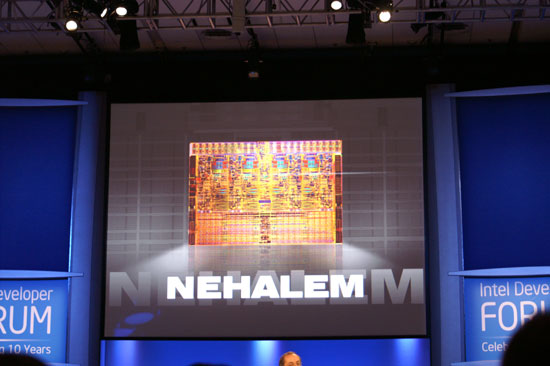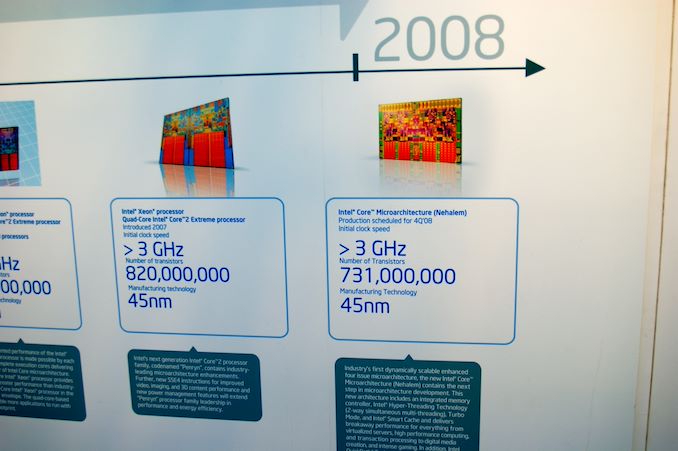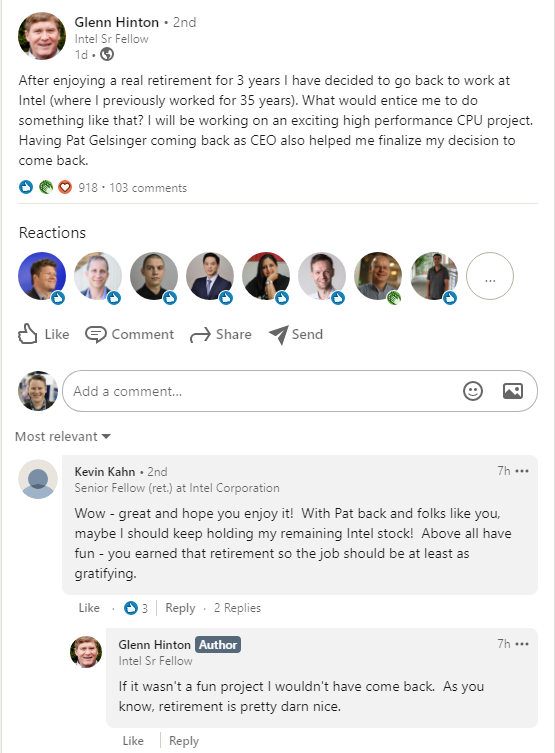New Intel CEO Making Waves: Rehiring Retired CPU Architects
by Dr. Ian Cutress on January 21, 2021 5:05 AM EST- Posted in
- CPUs
- Intel
- Nehalem
- Pat Gelsinger

We’re following the state of play with Intel’s new CEO, Pat Gelsinger, very closely. Even as an Intel employee for 30 years, rising to the rank of CTO, then taking 12 years away from the company, his arrival has been met with praise across the spectrum given his background and previous successes. He isn’t even set to take his new role until February 15th, however his return is already causing a stir with Intel’s current R&D teams.
News in the last 24 hours, based on public statements, states that former Intel Senior Fellow Glenn Hinton, who lists being the lead architect of Intel’s Nehalem CPU core in his list of achievements, is coming out of retirement to re-join the company. (The other lead architect of Nehalem are Ronak Singhal and Per Hammerlund - Ronak is still at Intel, working on next-gen processors, while Per has been at Apple for five years.)
Hinton is an old Intel hand, with 35 years of experience, leading microarchitecture development of Pentium 4, one of three senior architects of Intel’s P6 processor design (which led to Pentium Pro, P2, P3), and ultimately one of the drivers to Intel’s Core architecture which is still at the forefront of Intel’s portfolio today. He also a lead microarchitect for Intel’s i960 CA, the world’s first super-scalar microprocessor. Hinton holds more than 90+ patents from 8 CPU designs from his endeavors. Hinton spent another 10+ years at Intel after Nehalem, but Nehalem is listed in many places as his primary public achievement at Intel.
On his social media posts, Hinton states that he will be working on ‘an exciting high performance CPU project’. In the associated comments also states that ‘if it wasn’t a fun project I wouldn’t have come back – as you know, retirement is pretty darn nice’. Glenn also discloses that he has been pondering the move since November, and Gelsinger’s re-hiring helped finalize that decision. His peers also opine that Glenn is probably not the only ex-Intel architect that might be heading back to the company. We know a few architects and specialists that have left Intel in recent years to join Intel's competitors, such as AMD and Apple.
There are a few key things to note here worth considering.
First is that coming out of retirement for a big CPU project isn’t a trivial thing, especially for an Intel Senior Fellow. Given Intel’s successes, one would assume that the financial situation is not the main driver here, but the opportunity to work on something new and exciting. Plus, these sorts of projects take years of development, at least three, and thus Glenn is signing on for a long term despite already having left to retire.
Second point is reiterating that last line – whatever project Glenn is working on, it will be a long term project. Assuming that Glenn is talking about a fresh project within Intel’s R&D ecosystem, it will be 3-5 years before we see the fruits of the labor, which also means creating a design aimed at what could be a variety of process node technologies. Glenn’s expertise as lead architect is quite likely applicable for any stage of an Intel R&D design window, but is perhaps best served from the initial stages. The way Glenn seems to put it, this might be a black-ops style design. It also doesn't specify if this is x86, leaving that door open to speculation.
Third here is to recognize that Intel has a number of processor design teams in-house and despite the manufacturing process delays, they haven’t been idle. We’ve been seeing refresh after refresh of Skylake lead Intel's portfolio, and while the first iterations of the 10nm Cove cores come to market, Intel’s internal design teams would have been working on the next generation, and the next generation after that – the only barrier to deployment would have been manufacturing. I recall a discussion with Intel’s engineers around Kaby Lake time, when I asked about Intel’s progress on IPC – I requested a +10% gen-on-gen increase over the next two years at the time, and I was told that those designs were done and baked – they were already working on the ones beyond that. Those designs were likely Ice/Tiger Lake, and so Intel’s core design teams have been surging ahead despite manufacturing issues, and I wonder if there’s now a 3-4 year (or more) delay on some of these designs. If Glenn is hinting at a project beyond that, then we could be waiting even longer.
Fourth and finally, one of the critical elements listed by a number of analysts on the announcement of Gelsinger’s arrival was that he wouldn’t have much of an effect until 3+ years down the line, because of how product cycles work. I rejected that premise outright, stating that Pat can come in and change elements of Intel’s culture immediately, and could sit in the room with the relevant engineers and discuss product design on a level that Bob Swan cannot. Pat has the opportunity to arrange the leadership structure and instill new confidence in those structures, some of which may have caused key architects in the past to retire, instead of build on exciting projects.
As we can see, Pat is already having an effect before his name is even on the door at HQ.
Today is also Intel’s end-of-year financial disclosure, at 5pm ET. We are expecting Intel’s current CEO, Bob Swan, to talk through what looks to be another record breaking year of revenue, and likely the state of play for Intel's own 7nm process node technologies. That last point is somewhat thrown into doubt given the new CEO announcement and if Gelsinger is on the call. It is unknown if Gelsinger will participate.
Related Reading
- Intel Appoints Pat Gelsinger as New CEO, From Feb 15th
- An Interview with Intel CEO Bob Swan: Roundtable Q&A on Fabs and Future
- Robert Swan Named CEO of Intel













112 Comments
View All Comments
thedillyo - Thursday, January 21, 2021 - link
Should "Given Intel’s successes" be "Given Hinton’s successes"?forextor - Thursday, January 21, 2021 - link
Normally in situation like this people get young fresh blood instead of same 'ol same 'ol... why not steal apple's cpu architects?Valantar - Thursday, January 21, 2021 - link
Because Qualcomm already did? https://www.youtube.com/watch?v=-lq6vZcWLDMThe Hardcard - Thursday, January 21, 2021 - link
that is not necessarily the end of it. Company loyalists won’t move at all. However, once you switch companies it gets easier to do it again. Not unlike murder.mode_13h - Saturday, January 23, 2021 - link
> Not unlike murder.My, what a charming analogy. Not that I doubt it, but not the kind of thing you want to say in person.
FunBunny2 - Thursday, January 21, 2021 - link
I continue to be perplexed with this Apple fawning, ARM too for that matter. After centuries of maths and 80-ish years of computing machines, the notion that there are tectonic changes to computing, previously unknown, just waiting for some smart young kiddo to find? Balderdash. The Von Neumann machine still reigns. RISC owns the machine, although buried ever deeper below the 'ol same 'ol ISAs. I'll bet the only difference among all microprocessors within the actual computation engines is syntax/mnemonics. They all do the same maths.No one, to my knowledge, has figured out how to parallelize single-threaded user space problems on the fly, on the metal. I'd wager that 99.44% of 'innovation' in cpu over the last 3 decades has been three efforts:
- smaller transistors
- from that, hiding the real machine from the compiler, as above
- from that, ever more concentration of function into the 'cpu' chip that isn't computational
or to be brutal, has anyone devised a new ALU, ever? register width doesn't count.
so, it seems that most design these days amounts to deciding how to allocate the burgeoning of transistors (Apple seems to like expanding buffers and caches) and deciding what functions to assemble on the chip. which is not to say that Forrest Gump could do a good job
IOW, what new 'innovations' have been discovered in the fundamental computation process? I'll skip quantum computing, as it's, so far, been found irrelevant to all but a teeny, tiny niche of possible problems.
demian_thorne - Thursday, January 21, 2021 - link
In the grand scheme of things you are absolutely correct. We are still in the Von Neumann - Moore’s law level. Two observations.1. I think quantum computing is not to be discarded just that easily. It applies at the moment to some specific NP-problems but they are not trivial (encryption breaks) and it might apply to other areas as it evolves. It is too early to say ....
2. The Von Neumann basic architecture of two level storage -volatile and permanent- is I think going to be converged to one level storage permanent storage at the speeds of currently volatile storage.
Other than that, I agree with you ....
GeoffreyA - Thursday, January 21, 2021 - link
Agree fully.GeoffreyA - Thursday, January 21, 2021 - link
Or rather for the most part.JKflipflop98 - Friday, January 22, 2021 - link
In the book, Forrest is a mathematical savant. He might well come up with a new APU.